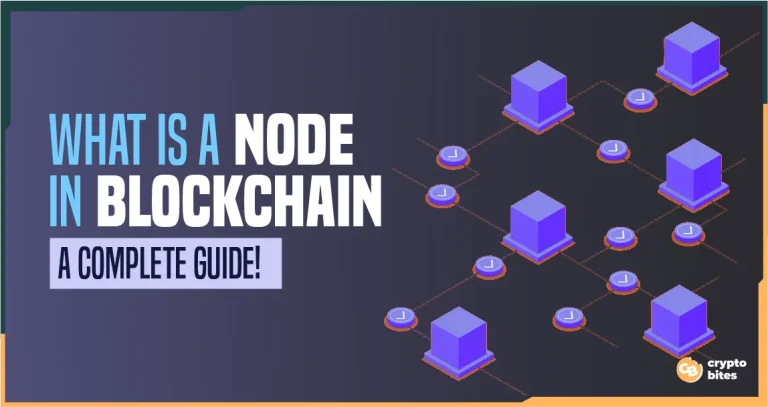
What is a Node in Blockchain – A Complete Guide!
A computer within a blockchain network is usually referred to as a node.
Nodes are crucial within a network since they have the authority to validate transactions taking place within a blockchain network.
Want to know more about nodes and how they work?
Well this guide then, is for you!
We will talk about what a node is in a blockchain, their types and their role in maintaining the integrity and security of the network
Let’s find out!
What is a Node in Blockchain?
A node in a blockchain network refers to any device, typically a computer, that participates in the network by executing the software for the blockchain protocol.
These nodes play a crucial role in validating transactions and maintaining the security of the network. They communicate with each other, exchanging messages to synchronize and update the blockchain’s ledger.
The decentralization of a blockchain network is determined by the number of nodes it has, with more nodes leading to greater decentralization.
Setting up a node on a blockchain is accessible to almost anyone. For instance, individuals can download software like Bitcoin Core to run a node for Bitcoin.
While some blockchains may restrict participation to specific nodes, such as Ripple, most follow the open model pioneered by Bitcoin, allowing anyone to join and contribute to the network.
How Does a Blockchain Node Work?
Blockchain nodes play a crucial role in ensuring the security and integrity of a blockchain network.
Each node is essentially a computer connected to the blockchain network, and its main function is to maintain a copy of the entire blockchain ledger and participate in the process of validating and relaying transactions.
Here’s how a blockchain node typically works:
Step 1 – Maintaining a Copy of the Blockchain
Each node inside the network keeps a duplicate of the whole blockchain ledger.. This ledger contains a record of all transactions that have ever occurred on the network, organized into blocks. By having a copy of the blockchain, each node can independently verify the validity of transactions and the current state of the network.
Step 2 – Validating Transactions
When a new transaction is broadcasted to the network, it is propagated to all nodes. Each node independently verifies the transaction to ensure that it follows the rules of the network (e.g., it has a valid digital signature, the sender has sufficient funds, etc.). If the transaction is found to be transparent, the node adds it to its copy of the blockchain.
Step 3 – Consensus Mechanism
Consensus mechanisms like Proof of Work (PoW) or Proof of Stake (PoS) are fundamental to blockchain networks, ensuring consensus among nodes on the validity of the transaction and their orderly inclusion in the blockchain.
In Proof of Work (PoW), nodes engage in competition to solve complex mathematical puzzles, verifying transactions and appending new blocks to the blockchain upon successful completion.
In contrast, Proof of Stake (PoS) selects nodes to verify transactions according to different standards, such as the quantity of bitcoin they own. This approach emphasizes ownership stake rather than computational work, offering an alternative consensus mechanism to PoW.
Step 4 – Network Communication
Nodes communicate with each other to propagate transactions and blocks throughout the network. This ensures that all nodes have the same view of the blockchain and can reach a consensus on the state of the network.
Step 5 – Security Measures
As mentioned, blockchain networks rely on the distributed nature of nodes to improve security.
For example, 51% of nodes must confirm a transaction for it to be allowed, the decentralized nature of the network makes it extremely difficult for a malicious actor to gain control of a majority of nodes.
This distributed consensus mechanism helps prevent fraud and ensures the integrity of the blockchain.
Overall, blockchain nodes play a vital role in maintaining blockchain security, integrity, and decentralization of blockchain networks by validating transactions, participating in the consensus process, and propagating information throughout the network.
Different Types of Nodes within Blockchain
Nodes are of different types each with its own unique capabilities:
1. Archival Full Nodes
Archival nodes store every transaction ever made on the blockchain, requiring a lot of RAM and space. Despite the resource demands, they’re valuable for maintaining the blockchain’s complete history and ensuring transparency and trust in the network.
2. Pruned Node
Pruned nodes are almost similar to archival full nodes with the only exception of keeping a completely copy of the blockchain.
Unlike their archival counterparts, pruned nodes operate on a limited memory budget. Once they download the blockchain, they start trimming it down, removing blocks starting from the oldest ones. This process, known as pruning, retains some but not all of the block’s sequence and information.
These nodes store only the most recent blockchain transactions, gradually discarding older data as they reach their memory limit. For instance, if the size limit is set at 1 GB, they might retain only the most recent gigabyte of transactions.
Despite having limited storage, pruned nodes perform almost all functions of a complete node.
3. Light Nodes
A light node is a type of node that specifically downloads and stores block headers. It relies on full nodes to function properly because it’s designed to prioritize essential data. Typically, it’s used for handling quick and simple transactions.
In the Ethereum ecosystem, a light node is a cost-effective choice. It only fetches crucial information needed for network transactions or Ethereum block headers.
It’s the simplest kind of node, different from the more detailed full and archive nodes.
While full nodes handle tasks like block validation and verification, light nodes concentrate solely on getting the minimum information necessary for Ethereum blockchain communication. Any extra data required comes from full nodes, which makes light nodes efficient tools for basic blockchain involvement.
4. Masternodes
While masternodes don’t have the ability to add blocks to the blockchain, they serve as comprehensive nodes responsible for verifying transactions and maintaining the blockchain.
The idea of masternodes, pioneered by cryptocurrencies like Dash (DASH), usually comes with specific requirements. Running a masternode typically demands specialized server hardware optimized for high-performance computing and a certain amount of the network’s cryptocurrency.
An important aspect is collateralization, where the masternode operator backs the node with a set amount of monetary assets. This ensures that masternodes are operated by individuals who are financially invested in the network’s success and security.
5. Mining Node
A mining node actively engages in cryptocurrency mining, playing a crucial role in the process. Through the blockchain’s consensus mechanism, mining nodes are chosen to validate and incorporate new blocks of transactions into the blockchain.
For instance, in proof of work systems like Bitcoin, a mining node competes with others to solve intricate mathematical puzzles. The first node to crack the puzzle earns the privilege to append a new block to the blockchain.
Miners, whether working solo or as part of a mining pool, constitute mining nodes. They vie to add the next transaction block to the blockchain, with the goal of earning transaction fees and newly minted cryptocurrency as a reward for their endeavors.
6. Authority Nodes
An authority node is a specialized participant within a blockchain network, typically designated by the governing body or community overseeing the blockchain’s operations.
In systems employing a proof-of-authority (PoA) consensus mechanism, authority nodes are granted the exclusive right to validate and add new transactions to the blockchain.
These nodes are usually operated by trusted entities or individuals who have undergone a screening process and provided identifying information.
Authority nodes play a critical role in maintaining the integrity, security, and governance of the blockchain network by ensuring that only authorized transactions are validated and added to the ledger.
7. Staking Nodes
Staking involves the action of a node locking up cryptocurrency funds as collateral. In blockchain systems utilizing a proof-of-stake mechanism, staking nodes are selected to validate transaction blocks. These nodes play a vital role in maintaining the integrity and security of the network.
A staking pool, which consists of individuals pooling their cryptocurrency assets to enhance their chances of being chosen to validate blocks, can be composed of a single staking node or multiple nodes. This pooling mechanism increases the collective stake and improves the probability of being selected to validate transactions on the blockchain.
8. Lightning Nodes
Off-chain transactions are facilitated by lightning nodes, which establish an alternative network for users to connect to. Upon completion, these transactions are then integrated into the main blockchain.
Lightning nodes prove particularly useful in congested blockchain networks characterized by high transaction fees and slow processing times. They enable cost-effective, nearly instantaneous transactions, offering a solution to the challenges posed by busy blockchain environments.
9. Super Nodes
Super nodes are upgraded versions of nodes in a blockchain network, generated as required for specific tasks like enforcing protocol changes or maintaining network protocols.
How Do You Run a Node?
Running a blockchain node demands significant resources like RAM, storage, and processing power, alongside the latest OS version and fast internet. Here’s a guide:
- Hardware Requirements: Ensure your system has sufficient RAM, storage space, and processing power to support the node’s operations effectively.
- Software Updates: Keep your operating system up to date to ensure compatibility and security with the latest node software.
- Internet Connection: A fast and stable internet connection is essential for seamless communication with the blockchain network.
- Continuous Operation: Your system should run uninterrupted for at least six hours daily to maintain network stability. Disable sleep or low-power modes to prevent interruptions during idle periods.
Following these guidelines, you can effectively run a blockchain node and contribute to the network’s operations.
Bottom Line
Running a node can be a rewarding way to participate in a cryptocurrency’s blockchain and earn rewards as a miner or validator.
However, it requires sophisticated software and technical expertise. Mining, staking, and light node operations all necessitate specialized knowledge and software.
To stay informed about the latest developments and news in the cryptocurrency industry, consider subscribing to our blog.
We regularly provide updates on new deals, trends, and information to keep you informed and engaged in the rapidly evolving world of cryptocurrencies.




